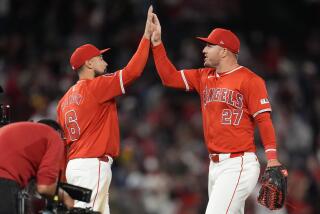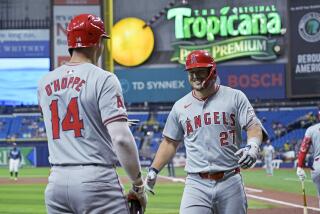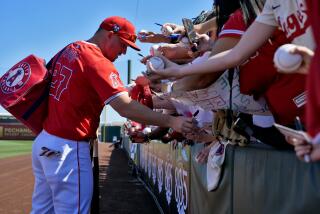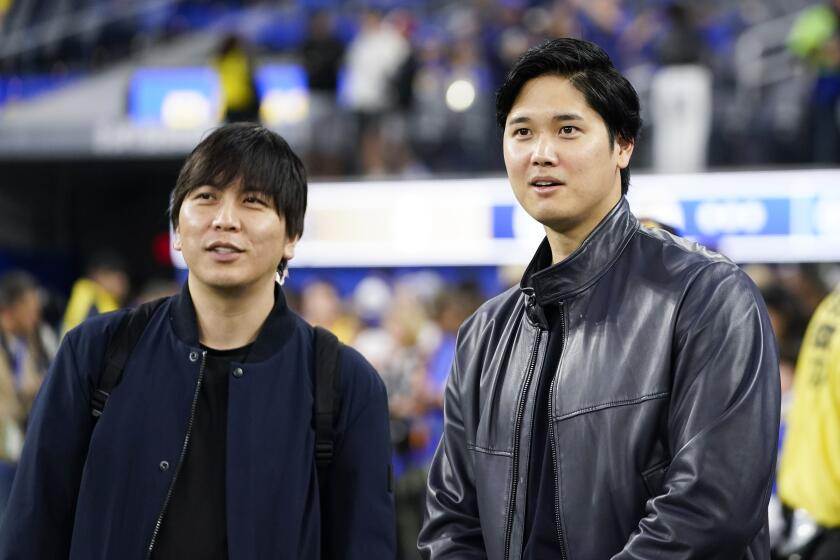Erstad Is Expected to Dive Into Duties
TEMPE, Ariz. — There seems to be a perception that because Darin Erstad is moving from center field -- where the Gold Glove winner was known for his acrobatic catches and fearless, some would say dangerous, approach -- to first base this season, he will be less prone to the injuries that have nagged him in recent years.
But just because Erstad will no longer slam into fences after 40-yard sprints, as he did in Detroit’s Comerica Park a few years back, it’s not as if the infield will be any less physically demanding than the outfield.
“He plays the game one way, and that’s not going to change,” said Terry Collins, the Angel manager in 1997 and ‘98, when Erstad last played first base regularly. “If he has to dive for a ground ball, he’ll dive. That’s who he is. He plays all out.”
The wear and tear of having to crouch with his glove near the ground on every pitch and the throwing mechanics of turning the double play from first took a toll on Erstad, who replaced the traded J.T. Snow at first in 1997 and moved from the outfield to first after Dave Hollins was injured in the middle of 1998.
Erstad had a sore right shoulder for much of the second half of 1997, didn’t start the final 13 games and had surgery after the season. In 1998, when Erstad played 72 games in the outfield and 70 at first, he strained his left hamstring in early August, went on the disabled list, aggravated the hamstring in early September and missed 10 more games.
“I’ve felt about the same at the end of the season whether I was in the infield or outfield,” said Erstad, who was limited to 67 games last season because of hamstring tendinitis. “I played first base and blew out my other hamstring. I wasn’t playing outfield then, so who knows?”
Angel Manager Mike Scioscia hopes to minimize Erstad’s injury risk by keeping him in the infield all season. “It would have to be an extreme circumstance” for Erstad to play outfield, Scioscia said Saturday. “That’s very difficult to do from a physical standpoint. In the infield, your arm is shortened up. It’s a big adjustment to go to the outfield and lengthen your arm.”
Erstad’s familiarity with first base should ease the transition.
“When I first moved there, I tried so many different throwing motions to see what works,” Erstad said. “Now, I know how to do it. I don’t have to try to find that again. I just have to get comfortable there.”
That, Erstad admitted, could take time. “That’s what spring is about, to get ready for the season,” he said.
Once he’s acclimated, there seems to be no doubt Erstad will excel at first.
“When he was there, he had a chance to be the best first baseman in the American League,” said Collins, now an instructor in the Dodger farm system. “He’s very athletic, quick on his feet and has great hands. He made some terrific reaction plays over there.”
Said Scioscia: “He can win a Gold Glove at first.”
*
There is no weight clause in Angel pitcher Bartolo Colon’s four-year, $51-million contract, but Scioscia would like the hard-throwing, 5-foot-11 right-hander to lose “a few” pounds this spring to get down to his usual playing weight, about 250 pounds.
“He’s not far off from where he needs to be,” Scioscia said. “He’ll shave some off in spring training, just like a lot of guys who lose five or six pounds. It’s not a concern.”
Nor is it a concern for Scioscia that the stocky Colon carries such weight. Colon is a workhorse who ranked second in the AL with 242 innings pitched last season and has a combined 49-33 record in the last three years
“Bartolo is a big man,” Scioscia said. “He feels good at the weights he’s pitched at before, and his record speaks for itself. We can’t impose any weight [restrictions] on him. The weight he feels his best at is where he’s at now.”
*
Pitcher Ramon Ortiz, who remained in Orange County for the birth of his son last week, is expected to report to camp today, undergo a physical and join workouts Monday.... Individual game tickets for the regular season will go on sale March 6 at 9 a.m. at Angel Stadium. Tickets will be available on a first-come, first-serve basis, and fans will be limited to a maximum of nine tickets per game.
More to Read
Go beyond the scoreboard
Get the latest on L.A.'s teams in the daily Sports Report newsletter.
You may occasionally receive promotional content from the Los Angeles Times.







